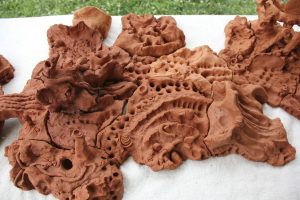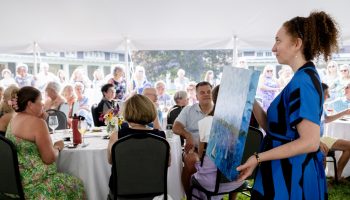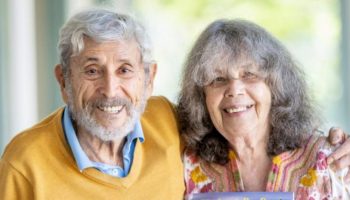
Students and emerging artists in Raheleh Filsoofi’s School of Art class spent several weeks this summer harvesting, cleaning and making clay, which they then used to create a social sculpture that will be installed at the School of Art next season.
When Raheleh Filsoofi leaves a new place, she takes a piece of it with her.
Throughout the summer, on a shelf in her studio at the School of Art, round plastic containers sat stacked on top of one another, filled with clay made from the soil of places she has visited. Samples range from Texas to Florida, and now, Chautauqua.
“It became a ritual to get some clay (and) go through a process to clean it and make it workable,” she said. “I’m creating a library, or archive of clay from different locations that I travel.”
Filsoofi is an artist and assistant professor of ceramics at the University of Texas Rio Grande Valley.
When she came to the School of Art as a core faculty member this season, she saw an opportunity to bring the students and emerging artists into her process.
“At Chautauqua, I got a chance with this class to explore a little more and see what we could actually create with that clay,” she said.
With the help of 15 students and emerging artists in her class, Filsoofi made a plan to locate natural clay around the Institution. She used an online program called Web Soil Survey to find the ideal spot.
“That really helped me to go do that in a very practical way,” Filsoofi said. “We located the clay through this website, and we saw what we have around us and where it’s better to (dig).”
Filsoofi and her class harvested clay from the woods in the South End Ravine near Thunder Bridge.
“It was very fun,” she said. “We were out of our studios (and) more connected with nature itself.”
This began the two-week process of cleaning the clay to make it workable for sculpture and pottery. It was the first time most of the students and emerging artists had ever made clay.

“I knew that (creating with) clay has many stages,” said Danqi Cai, who recently earned her bachelor’s degree from the Maryland Institute College of Art. “It can be slick, or leather-hard or bone dry or viscous, but we (learned about) the stages that come before, … and it also has many, many steps.”
The clay was left outside the School of Art to dry for a week. Filsoofi’s class then spent a week mashing the dry pieces and processing them to be workable and able to withstand firing in a kiln.
Ashanté Kindle, who recently earned her bachelor’s degree from Austin Peay State University in Clarksville, Tennessee, said making her own clay has changed the way she thinks about the materials in her work.
“This has forced me, going forward, to become more familiar with my materials and actually allow (them) to speak to me,” Kindle said.
With the clay processed, Filsoofi’s class met for a session of improvised, collaborative sculpting. All 15 students and emerging artists worked together to create what Filsoofi calls a “Social Sculpture.”
“We started to think about certain words or phrases or memories of this place and our feelings towards it to help facilitate (the sculpture),” said Shannon Stovall, who earned her Master of Fine Arts from the School of Visual Arts in New York City this year. “I don’t think any of us had anything specific in mind when we started making it.”
The work was created in one session and sprawls out more than 3 feet long, in a variety of shapes and textures, from twisting spires to tiny dots.
Filsoofi’s class discussed dismantling the sculpture and returning the clay back to the creek bed, but ultimately decided to fire it in the kiln at the beginning of Week Seven, the last week of operation for the School of Art.
“These are decisions we are making together,” Filsoofi said, “because nobody can claim it anymore.”
Many of the students and emerging artists in Filsoofi’s class said the collaborative nature of this project is something they will carry into their own artistic practices.
“It took me back to childhood, where you are playing off each other,” said Tessa Dallarosa, who earned her Master of Fine Arts from the School of Art Institute of Chicago. “You (could) get into each other’s space.”
Kris Rumman, who earned her Master of Fine Arts from Philadelphia’s Tyler School of Art at Temple University last year, agreed.
“It felt like, you know those principles of improvisation, where somebody puts something forward –and you have to affirm it? ‘Yes, and?’ It felt so easy to play,” she said.
Besides exploring the natural resources around the Institution, Filsoofi used the project to ask questions about the land itself.
“We’re looking at the history of this place, but also who this place belonged to,” she said.
“I am indigenous” is carved into the clay of a section created by Rumman. It is the only text in the piece. Chautauqua County sits on land belonging to the Erie and Haudenosaunee indigenous tribes.
“The clay is from indigenous land – that is not ever really considered here at Chautauqua,” Stovall said. “That is an important part of this.”
The sculpture will be installed at the School of Art next year. Filsoofi, who will return as a core faculty member for the 2020 season, plans to continue this project by making a new social sculpture with next season’s students and emerging artists.
She was impressed with how her class tackled the arduous, weeks-long process of making clay.
“It takes dedication,” she said. “Physically, mentally (and) emotionally, … it’s exhausting. Having that commitment from the group for a few weeks is such an interesting experience. It’s very valuable.”
As someone who is used to making clay from dry or sand-filled areas, Filsoofi said she was pleased with the “generous” nature of Chautauqua clay, which she said is easy to work with and produces a deep rust color when fired at low temperatures.
“It’s beautiful to touch and work with,” she said. “And it smells terrible because there’s so much silt in it, but we could endure that.”




